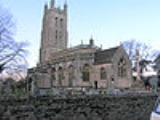
Church of All Saints, Wrington
Encyclopedia
The Church of All Saints in Wrington
, Somerset
, England has 13th-century foundations, and was remodelled with the addition of a west tower around 1450. It is a Grade I listed building.
Wickham dates the church to the period from 1420 to 1450, and Freeman described it as "one of the "highest achievements of architectural genius". The tower was completed around 1449.
The church was restored in 1859 with further restoration to the four-stage 113.5 feet (35 m) tower in 1948. The tower has set-back buttress
es which develop into crocketted pinnacle
s at the top stage. The top displays moulded string courses and a trefoil pierced triangular parapet
with gargoyle
s and corner pinnacles. The belfry stair is in the south-east turret
.
The interior includes stone busts to John Locke
and Hannah More
dating from the early 19th century on either side of the door. The chancel
has Gothic
reredos
by Charles Barry
dating from 1832. The rood screen is from the 16th century.
Wrington
Wrington is a village and civil parish in North Somerset, England. It lies in the valley of the Congresbury Yeo river about east of Weston-super-Mare and south-east of Yatton. It is both a civil parish, with a population of 2,896, and an ecclesiastical parish...
, Somerset
Somerset
The ceremonial and non-metropolitan county of Somerset in South West England borders Bristol and Gloucestershire to the north, Wiltshire to the east, Dorset to the south-east, and Devon to the south-west. It is partly bounded to the north and west by the Bristol Channel and the estuary of the...
, England has 13th-century foundations, and was remodelled with the addition of a west tower around 1450. It is a Grade I listed building.
Wickham dates the church to the period from 1420 to 1450, and Freeman described it as "one of the "highest achievements of architectural genius". The tower was completed around 1449.
The church was restored in 1859 with further restoration to the four-stage 113.5 feet (35 m) tower in 1948. The tower has set-back buttress
Buttress
A buttress is an architectural structure built against or projecting from a wall which serves to support or reinforce the wall...
es which develop into crocketted pinnacle
Pinnacle
A pinnacle is an architectural ornament originally forming the cap or crown of a buttress or small turret, but afterwards used on parapets at the corners of towers and in many other situations. The pinnacle looks like a small spire...
s at the top stage. The top displays moulded string courses and a trefoil pierced triangular parapet
Parapet
A parapet is a wall-like barrier at the edge of a roof, terrace, balcony or other structure. Where extending above a roof, it may simply be the portion of an exterior wall that continues above the line of the roof surface, or may be a continuation of a vertical feature beneath the roof such as a...
with gargoyle
Gargoyle
In architecture, a gargoyle is a carved stone grotesque, usually made of granite, with a spout designed to convey water from a roof and away from the side of a building thereby preventing rainwater from running down masonry walls and eroding the mortar between...
s and corner pinnacles. The belfry stair is in the south-east turret
Turret
In architecture, a turret is a small tower that projects vertically from the wall of a building such as a medieval castle. Turrets were used to provide a projecting defensive position allowing covering fire to the adjacent wall in the days of military fortification...
.
The interior includes stone busts to John Locke
John Locke
John Locke FRS , widely known as the Father of Liberalism, was an English philosopher and physician regarded as one of the most influential of Enlightenment thinkers. Considered one of the first of the British empiricists, following the tradition of Francis Bacon, he is equally important to social...
and Hannah More
Hannah More
Hannah More was an English religious writer, and philanthropist. She can be said to have made three reputations in the course of her long life: as a poet and playwright in the circle of Johnson, Reynolds and Garrick, as a writer on moral and religious subjects, and as a practical...
dating from the early 19th century on either side of the door. The chancel
Chancel
In church architecture, the chancel is the space around the altar in the sanctuary at the liturgical east end of a traditional Christian church building...
has Gothic
Gothic architecture
Gothic architecture is a style of architecture that flourished during the high and late medieval period. It evolved from Romanesque architecture and was succeeded by Renaissance architecture....
reredos
Reredos
thumb|300px|right|An altar and reredos from [[St. Josaphat's Roman Catholic Church|St. Josaphat Catholic Church]] in [[Detroit]], [[Michigan]]. This would be called a [[retable]] in many other languages and countries....
by Charles Barry
Charles Barry
Sir Charles Barry FRS was an English architect, best known for his role in the rebuilding of the Palace of Westminster in London during the mid-19th century, but also responsible for numerous other buildings and gardens.- Background and training :Born on 23 May 1795 in Bridge Street, Westminster...
dating from 1832. The rood screen is from the 16th century.

